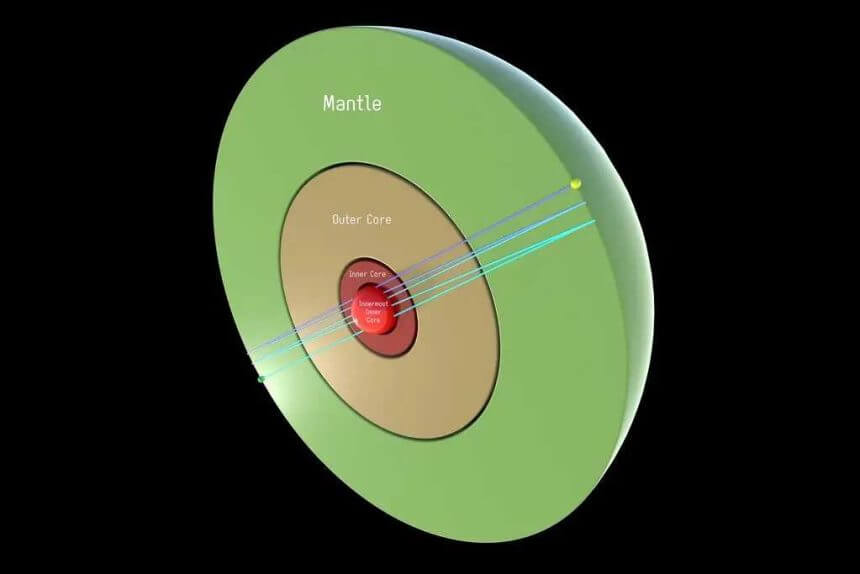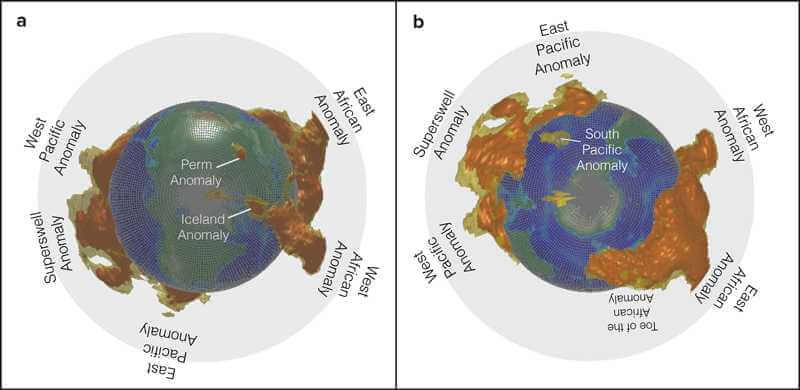
400 Mile Thick Solid Metallic Ball Found Inside Earth’s Core: Underground World?
Beliefs in mysterious underworlds are as old as humanity. But the idea that the earth has a hollow interior was first proposed as a scientific theory in 1691 by Sir Edmond Halley (of comet fame), who suggested that there might be life down there as well.
By: Vicky Verma | How & Whys
It has been previously thought that Earth is composed of four different layers: inner core, core, mantle, and crust. But a recent scientific discovery might change the way we see Planet Earth. Scientists claimed to they have found one more layer inside the inner core that takes the form of a solid, metallic sphere situated at the core’s centre. It is not molten but solid.
A recent study published in the journal Nature Communications reveals that scientists have detected a 400-mile-thick solid metallic layer located at the Earth’s innermost core. This layer responds differently than previously known layers to earthquake shockwaves.
The research was conducted by a team of two seismologists from the Australian National University (ANU), who speculates that this “innermost inner core” found inside Earth might have originated from a significant global occurrence in the past. Two Harvard seismologists, Miaki Ishii and Adam Dziewonski, first proposed the idea of the innermost inner core in 2002 based on peculiarities in the speed of seismic waves passing through the inner core.

The research states scientists have discovered up to fivefold reverberating waves from earthquakes along the Earth’s diameter, using a growing number of global seismic stations. This has enabled them to probe the Earth’s centre and infer a transversely isotropic inner-core model that contains an anisotropically distinctive innermost inner core and its transition to a weakly anisotropic outer shell.
These findings improve current knowledge of the Earth’s formation and evolution and suggest that the anisotropy could be a fossilized record of a significant global event from the past. This research has shed light on our planet’s evolution over billions of years, including the development of the Earth’s magnetic field, which transformed it from an uninhabitable terrain into a habitable abode.
Dr. Thanh-Son Phạm, from the ANU Research School of Earth Sciences, stated that around two decades ago, a hypothesis was proposed about the presence of an internal metallic ball in the innermost core. According to Dr. Phạm, they are now presenting another line of evidence to support this hypothesis.
The ANU scientists describe this process as similar to a ping pong ball bouncing back and forth. “By developing a technique to boost the signals recorded by densely populated seismograph networks, we observed, for the first time, seismic waves that bounce back – and forth up to five times along the Earth’s diameter. Previous studies have documented only a single antipodal bounce,” Dr. Phạm said. (Source)
“This inner core is like a time capsule of Earth’s evolutionary history – it’s a fossilized record that serves as a gateway into the events of our planet’s past. Events that happened on Earth hundreds of millions to billions of years ago,” said in a statement one of the researchers, Hrvoje Tkalčić.
Scientists studied one of the earthquakes that originated in Alaska. Its seismic waves were observed to bounce off a location in the South Atlantic Ocean before returning to Alaska.
The researchers investigated the anisotropy of the iron-nickel alloy that forms the Earth’s inner core. Anisotropy refers to the way seismic waves speed up or slow down depending on their direction of travel through the Earth’s inner core, potentially caused by varying arrangements of iron atoms at high temperatures and pressures or preferred alignment of growing crystals.
The scientists discovered that the bouncing seismic waves probed the Earth’s centre from different angles multiple times. By examining the travel times of seismic waves for various earthquakes, the researchers inferred that the crystallized structure within the innermost region of the inner core is likely different from the outer layer. This discrepancy could explain why seismic waves change speed depending on their entry angle as they penetrate the innermost part of the inner core.
According to the researchers, the formation of this metallic ball could have been triggered by a major global event, such as a large tectonic shift that occurred millions of years ago. Its significance lies in its potential role in supporting the thriving of life on Earth. As a crucial piece of the puzzle, it provides a captivating insight into our planet’s distant past.
Another Similar Discovery
Since the 1970s, the discovery of two giant structures inside the Earth has baffled scientists. They are located on opposite sides of our planet, and their size may be compared to continents. Each of these structures is almost 100 times bigger than Mount Everest and is located at the core of the Earth, at a depth of 2900 km. (Click here to read article)
Seismic studies show that the discovered formations have a different composition than the rest of the Earth’s mantle. These waves generated by earthquakes travel through the Earth’s interior, changing speed, bending, or scattering as they pass through different materials. Scientists use seismometers to detect these waves and create a picture of the rock below the surface.
A recent study used a machine-learning algorithm to analyse around 7,000 seismic wave records, revealing new information about three-dimensional structures near the core-mantle boundary in the sub-Pacific region of Earth.

Geophysicists have known about these structures anomalies (generally they call them blobs) since the 1970s but are not much closer to understanding them today.
“They’re among the largest things inside the Earth,” University of Maryland geologist Ved Lekic told Eos reporter Jenessa Duncombe, “and yet we literally don’t know what they are, where they came from, how long they’ve been around, or what they do.”
The blobs begin thousands of miles below Earth’s surface, where the planet’s rocky lower mantle meets the molten outer core. One blob lurks deep below the Pacific Ocean, the other beneath Africa and parts of the Atlantic. Both are massive, stabbing up about halfway through the mantle and measuring as long as continents. According to Duncombe, each blob stretches about 100 times higher than Mount Everest; if they sat on the planet’s surface, the International Space Station would have to navigate around them.
These discoveries suggest that Earth is hiding many secrets within which are yet to reveal. Could there be a hidden civilization inside these structures?
Comparing ancient texts and megalithic architecture reveals an anthropological connection between civilizations that were considered technologically inferior and geographically removed from one another. The Silurian Hypothesis by Schmidt & Frank and Ultraterrestrial Models by H. E. Puthoff have evolved out of a process of elimination that has taken decades to come to light due to the layered nature of the phenomena and the incommensurability problem.
Now That’s Interesting
In 1869 an American physician named Cyrus Reed Teed, whose very own brand of medicine combined alchemy with zaps of electricity and doses of magnetism, electrocuted himself so badly that he passed out. Which is just as well, for when he came to, he realized he was the living incarnation of Jesus Christ. Not only that, he also decided that the Earth is actually an inverted sphere: We line the inside and look in on, not out to, the rest of the universe.
* * *
READ MORE: The Church of Vrilology, Vril, Hitler & The Hollow Earth
Read more on The Hollow Earth Theory: Two Mountains 100 Times Higher Than Mt. Everest Found Inside Earth Trigger Hollow Earth Theory
Liked it? Take a second to support Collective Spark.
We’d love to hear from you! If you have a comment about this article or if you have a tip for a future Collective Spark Story please let us know below in the comment section.
